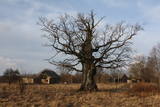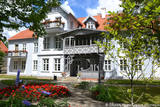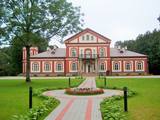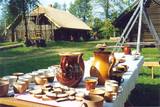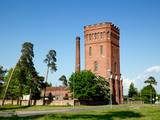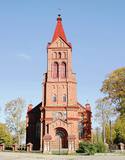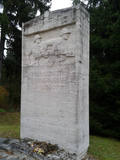| No | Name | Description |
|---|---|---|
|
A small settlement with a school, library and shop. North from the Vidale are visible remains of the windmill. Going towards the Gulf of Riga, the road crosses Shlitere Zilie mountain precipice with spectacular views during late autumn, early spring and winter, when there are no leaves on the trees and sandstone outcrops. To the left you can see Zilie mountain spring - a landscaped water taking place. Road that runs from the Vidale to Melnsils side, is called by the locals Knipeldambi. They say that it was built by the German army first During World War I, putting logs on the road and covering them with sand. |
||
|
This little tram offers a great opportunity to return to history, when small trams were found all over Latvia. Until the 1960s, there was a narrow-gauge railroad that linked shoreline fishing villages along the shores of Northern Kurzeme. Only a few remnants of the old tracks can still be found in nature, and there are only a few train stations or parts thereof. Visitors to the Ventspils Open Air Museum can take the 1.4 km Circle Line or the 3 km Mountain Line. The locomotive was built in Germany in 1916, and the museum features a station building with all of its elements. |
||
|
The Šilute Estate is often described on the basis of its last owner, Hugo Scheu, who bought the estate in 1889. He restored the estate's buildings and territory, also installing two parks, one for the estate, and the other one known as the "raven forest." Alongside the estate is an English-type park with strolling trails. The park is used by local residents and is on both sides of the curvy Scheu River, with the banks connected by pedestrian bridges. He park stretches to an old railroad bridge and has approximately 150 types of plants, including 40 types of trees and shrubs. |
||
|
Atrodas Labraga – Apriķu ceļa malā. Kāds nostāsts vēsta, ka to 1896. gadā cēlis vietējais muižkungs, kurš vēlējies, lai viņa meitas laulības notiktu baznīcā. Dievnamā atrodas altārglezna "Kristus pie krusta un Sv. Marija Magdalēna", kas gleznota 19. gadsimtā (autors T. Šprengels). |
||
|
Andris Roze is one of very few kokle makers in Latvia who manufactures the instrument and helps others to do so at master’s classes. Roze also manufactures other traditional musical instruments, demonstrates them, offers consultations about them, collects them and gathers together historical information. He works at the Drabeši Crafts House, where people can learn traditional skills such as weaving, processing of leather, felting, pottery and construction of musical instruments. |
||
|
This is Latvia’s thickest common pine (Pinus slyvestris)
|
||
|
Piedāvā ļoti gardus Lietuviešu tradicionālos ēdienus. Var pieņemt līdz 80 personām. Pieņem bankas kartes, ir āra terase un dzīvā mūzika. Pieejama autostāvvieta. |
||
|
The Alantos Estate is in the village of Naujasodžio, and it was built in the style of Neo-Classicism in the 19th century. The estate is surrounded by a park with many types of trees, as well as a set of ancillary buildings. The mansion is reminiscent of an Italian villa, and the Neo-Romantic park has alleys of trees and three ponds of various sizes. The trees were planted so that over the course of time, their trunks would grow together to ensure mighty crowns. Alongside the park are a few gazebos, an obelisk that stands a few metres high, as well as white marble sculptures of Venus and Jupiter. |
||
|
This is one of the highest points among the hillocks of the Selonian area of Zemgale – Borīškalns Hill. From the tower, you will see Lake Sauka, as well as the forests and farmland which surround it. The “Kalna Ļūdāni” farm is nearby, and its owner uses his livestock to help to maintain the surrounding landscape.
|
||
|
Представлен сельский двор среднезажиточного крестьянина Селии XIX века, в котором находится жилой дом с оболочной дымовой трубой, два амбара, рига, баня, ветряная мельница и кузница, паровой локомобиль и молотилка. Туристическим группам предлагаются тематические программы: «Ремесленные работы во «Дворе селов», «Когда мед тает на языке» и «Женитьба во «Дворе селов». |
||
|
В окружении жилых (в т.ч. брошенных) зданий возвышается построенная в 1905 году из красных кирпичей в стиле псевдоготики 37-метровая Тосмарская водонапорная башня. В свое время с помощью насосов на паровых двигателях (сохранились до наших дней) воду из скважины качали в башенный резервуар. Оттуда ее трижды в день подавали жителям Каросты. В настоящее время водонапорная башня больше не выполняет свои „прямые” обязанности. Наружный осмотр возможен в любое время. В масштабе Латвии уникальный объект индустриального наследия. |
||
|
Viens no diviem nacionālā parka skatu torņiem, kas atrodas ~ 1,5 km ziemeļos no Ehijerva ezera (Ähijärv). Tornis ir veiksmīgi „nomaskēts” nelielā priežu pudurī, tādēļ tas „nebojā” izcilo dabas un kultūrainavu, kas paveras no tā skatu platformas. Pie autostāvlaukuma ir izveidota labiekārtota atpūtas vieta. |
||
|
Юрмала (второй по величине город Латвии) основан в 1959 году, путем объединения городов Кемери и Слока с Юрмальским районом города Риги. Юрмала протянулась на 32 километра вдоль побережья Рижского морского залива. В свое время курорт Юрмалы был одним из известнейших объектов подобного рода в Северной Европе. Этому способствовало развитие местного и международного транспорта (дилижансы, паровозы, поезда) и движения. Первых гостей-купальщиков приняли Дубулты, где в 1834 году построили первую гостиницу, а в 1847 – первый курзал. В XIX веке начали работать первые лечебные учреждения. С 1834 г. началось стремительное строительство гостиниц. Развитие курорта прервала Первая мировая война. После войны снова наблюдался быстрый расцвет курорта – от 12 тысяч (1920 г.) до 32 тысяч (1935 г.) отдыхающих. Подобно юрмальским развивались и кемерские курорты, массовый характер которые приобрели в советский период. Современная Юрмала – популярное место проведения концертов, фестивалей, выставок, спортивных соревнований и других публичных мероприятий. |
||
|
Цискадский Римско-католический костёл Св. Иоанна Крес-тителя
построен в романском стиле в 1900 году из камня и красного кирпича. В
костёле находятся картина „Мадонна с младенцем”, распятие и орган.
|
||
|
Кондитерская - кафе в Саулкрасты, недалеко от железнодорожной станции Саулкрасты. Предлагают выпускаемые изделия кондитерского магазина - пирожки, сдобные булочки, пирожные, кексы и блюда на все случаи жизни. В Саулкрасты на ул. Райня, д. 7, находится второе кафе. Латышская кухня: Холодный суп, рассол, квашеная капуста, домашние котлеты, серый горох с салом. Особое блюдо: Пиццы, приготовленные в дровяной печи. |
||
|
Румбульский аэродром как военный аэродром основан после Второй мировой войны – в месте, где на берегах Даугавы расположилось много хуторов. После того, как аэродром Спилве прекратил свое функционирование, летательные аппараты гражданской авиации переместились на Румбулу, а военная авиационная техника – в аэропорт «Рига». В наши дни название «Румбула» больше ассоциируется с Румбульским авторынком, часть которого заняла территорию бывшего аэродрома. В качестве своего рода «наследства» стоит упомянуть оставшееся загрязнение от бывших резервуаров для горючего, где на аэродроме хранился керосин. На территории аэродрома проходят полеты на парапланах.
|
||
|
The Capital of Latvia. The Old Town of Riga (included in UNESCO Cultural Heritage list) - an excellent medieval building monument. The pearl of Art Noveau in Europe. The former city of Hanza. |
||
|
Находится на обочине шоссе Р 100 (недалеко от шоссе А 8, направление на Озолниеки и Елгаву). Памятник посвящен стрелкам 6-го Рижского пехотного полка, павшим и пропавшим без вести в боях с бермонтовцами 17-го ноября 1919-го года возле бывшей основной школы Скуяс. Памятник (автор Николай Войт, автор барельефа Мартиньш Шмалцс, консультант Карлис Зале) был открыт 24-го октября 1937-го года. Его отреставрировали в 2009-м году. |
||
|
In terms of shape, this is one of the most diverse areas of uncovered sandstone in Latvia. Found on the right bank of the Gauja river, the Sietiņiezis is up to 15m high. Small holes that can be seen in the cliff face are created by single and protected insects, which carve tiny caves in the cliff for their caterpillars. A circular and well appointed trail, with stairs, has been installed. It is 1.5 km in length and will take an hour or so to traverse. Objects are in the Gauja National Park.
|
||
|
Territory established mainly for protection of bog myrtle and various bird species. An interesting fact is that bog myrtle or sweet gale is used as ingredient for making famous Riga Black Balsam. Brienamais purvs (wade bog) is hard to find and reach therefore it is not suitable for tourism.
|
||
